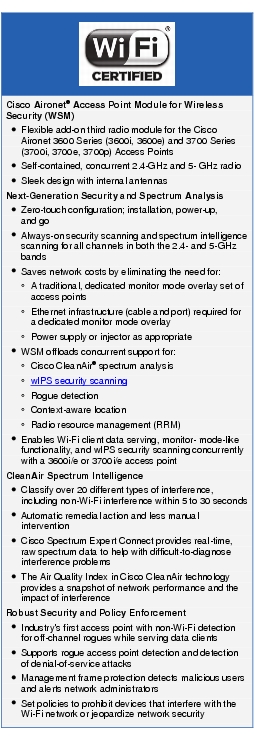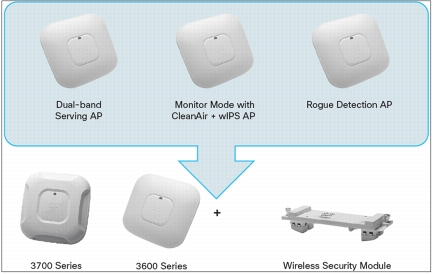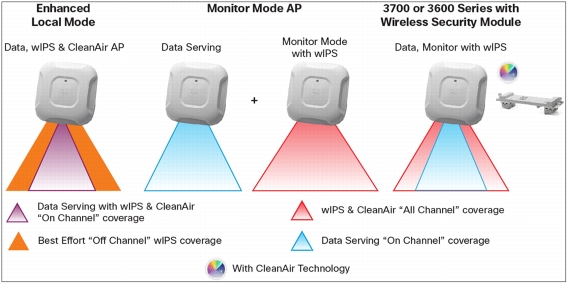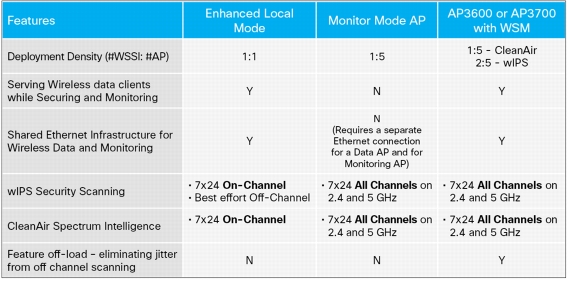|
|


The Cisco® Wireless Security module (WSM), taking advantage of the flexible modular design introduced with the Cisco Aironet® 3600 Series Access Points and carried forward with the Cisco Aironet® 3700 Series Access Points, delivers unprecedented, always-on security scanning and spectrum intelligence, which helps you avoid RF interference so that you get better coverage and performance on your wireless network.
• 24/7 full spectrum monitor and mitigation for adaptive wireless intrusion prevention system (AwIPS), CleanAir, Context Awareness, Rogue Detection and Radio Resource Management
• 24/7 on-channel AwIPS threat protection
• 23x more security and spectrum coverage
• 30%+ CAPEX cost savings versus dedicated monitor mode access point
• Zero touch configuration
Modular Flexibility and Efficiency
• Reduce network costs and operations. By integrating the WSM into the Aironet 3700 or 3600 Series Access Points, customers have the ability to replace up to three separate access points and their separate functions into a single, multipurpose access point (Figure 1).
Figure 1. Integrating Three Separate Functions into a Single WSM with Either the 3700 or 3600 Series Access Point

• Zero-touch configuration, installation, power-up, and go. Absolutely no configuration is required to get the WSM up and running and immediately monitoring and securing your wireless network. The WSM is inserted and secured into any Aironet 3600 or 3700 Series access point. When the access point is powered back up, the module is initialized, along with the other radios in the access point, and immediately begins monitoring all channels on both 2.4 and 5 GHz for any potential sources of interference.
• Adaptive wIPS (AwIPS),1 providing accurate and efficient threat detection on all channels from over-the-air attacks, rogue access points, clients, and ad hoc connections, as well as the ability to classify, notify, mitigate and report for constant monitoring and proactive management. Works in conjunction with the Cisco Mobility Services Engine (MSE).
Figure 2. Different Modes wIPS Detection Supported

• Adds wIPS security scanning for 7x24 on-channel scanning (2.4 and 5 Ghz), with best-effort off -channel support.
• The Aironet access point is additionally serving clients and with the G2 Series of access points enables CleanAir spectrum analysis on channel (2.4 and 5 GHz).
• The Aironet access point is dedicated to operate in Monitor mode and has the option to add wIPS security scanning of all channels (2.4 and 5 GHz).
• The G2 Series of access points enable CleanAir spectrum analysis of all channels (2.4 and 5 GHz).
• Monitor mode access points do not serve clients.
• The industry's first access point that provides the ability to simultaneously serve clients and perform wIPS security scanning and spectrum analysis with Cisco CleanAir technology.
• Dedicated 2.4- and 5-GHz radio with its own antennas, enabling around-the-clock scanning of all wireless channels in the 2.4- and 5-GHz bands.
• A single Ethernet infrastructure provides simplified operation with fewer devices to manage and optimized return on investment of the wireless infrastructure and the Ethernet wired infrastructure.
Table 1. Specifications for Various Type of wIPS Options Available

• Cisco CleanAir technology: Proactive, high-speed spectrum intelligence to combat performance problems due to wireless interference. The industry's first state-of-the-art radio frequency analysis technology that inspects and classifies the energy patterns (signatures) of devices that can significantly impact the quality of a wireless network.
• Radio resource management (RRM): Simplified, advanced RF management that automatically adapts to the wireless network environment based on the information received from Cisco's CleanAir technology. Once interferers are identified, RRM is able to move client devices to channels away from the interference and also adjust the transit power away from the source of interference.
• Rogue detection: Detects and reports back-door network access and access to wireless clients.
• Location and context awareness: Provides real-time awareness and the ability to track wireless endpoints.
Product Specifications
Table 2. Product Specifications for Cisco Aironet Wireless Security Module
|
Item |
Specification |
|||
|
Part Numbers |
Cisco Aironet Access Point Module for Wireless Security • AIR-RM3000M=: Wireless Security and Spectrum Intelligence Module
• AIR-RM3000M-10=: Wireless Security and Spectrum Intelligence Module, 10 Pack
Wireless Intrusion Prevention System (wIPS) Licenses - to enable full wIPS support with the WSM Cisco SMARTnet® Service for the Cisco Aironet Access Point Module for Wireless Security Module CON-SNT-RM3000M: SMARTnet 8x5xNBD WSM (dual-band 2.4 and 5 GHz) • CON-SNT-RM3000M - SMARTnet 8x5xNBD Wireless Security Module (dual-band 2.4 and 5 GHz)
• Qty(10) CON-SNT-RM3000M - SMARTnet 8x5xNBD 10 quantity eco-pack WSM (dual-band 2.4 and 5 GHz)
Cisco Wireless LAN Services • AS-WLAN-CNSLT: Cisco Wireless LAN Network Planning and Design Service
• AS-WLAN-CNSLT: Cisco Wireless LAN 802.11n Migration Service
• AS-WLAN-CNSLT: Cisco Wireless LAN Performance and Security Assessment Service
|
|||
|
Software |
• With the Aironet 3600 Series Access Point: Cisco Unified Wireless Network Software Release 7.4 or later
• Mobility Services Engine Release 7.4 or later - to visualize and track CleanAir, wIPS, location results
• Cisco Prime™ Infrastructure Release 1.3 or later - to enable wIPS capability
|
|||
|
• With the Aironet 3700 Series Access Point: Cisco Unified Wireless Network Software Release 7.6 or later
• Mobility Services Engine Release 7.6 or later - to visualize and track CleanAir, wIPS, location results
• Cisco Prime Infrastructure Release 1.4.1 or later - to enable wIPS capability
|
||||
|
Supported Wireless LAN Controllers |
• Cisco 2500 Series Wireless Controllers, Cisco Wireless Controller Module for ISR G2, Cisco Wireless Services Module 2 (WiSM2) for Catalyst® 6500 Series Switches, Cisco 5500 Series Wireless Controllers, Cisco Flex® 7500 Series Wireless Controllers, Cisco 8500 Series Wireless Controllers, Cisco Virtual Wireless Controller
|
|||
|
Regulatory |
• The WSM is a receive-only 2.4-GHz and 5-GHz radio, compatible with all regulatory domains
|
|||
|
Operating Frequency Range |
2.4 GHz 2400-2483.5 MHz |
5 GHz 5150-5350, 5470-5850 MHz |
||
|
Frequency Band and 20-MHz Operating Channels |
A (A regulatory domain): • 2.412 to 2.462 GHz; 11 channels
• 5.180 to 5.320 GHz; 8 channels
• 5.500 to 5.700 GHz, 8 channels
(excludes 5.600 to 5.640 GHz) • 5.745 to 5.825 GHz; 5 channels
C (C regulatory domain): • 2.412 to 2.472 GHz; 13 channels
• 5.745 to 5.825 GHz; 5 channels
E (E regulatory domain): • 2.412 to 2.472 GHz; 13 channels
• 5.180 to 5.320 GHz; 8 channels
• 5.500 to 5.700 GHz, 8 channels
(excludes 5.600 to 5.640 GHz) I (I regulatory domain): • 2.412 to 2.472 GHz, 13 channels
• 5.180 to 5.320 GHz; 8 channels
K (K regulatory domain): • 2.412 to 2.472 GHz; 13 channels
• 5.180 to 5.320 GHz; 8 channels
• 5.500 to 5.620 GHz, 7 channels
• 5.745 to 5.805 GHz, 4 channels
|
N (N regulatory domain): • 2.412 to 2.462 GHz; 11 channels
• 5.180 to 5.320 GHz; 8 channels
• 5.745 to 5.825 GHz; 5 channels
Q (Q regulatory domain): • 2.412 to 2.472 GHz; 13 channels
• 5.180 to 5.320 GHz; 8 channels
• 5.500 to 5.700 GHz; 11 channels
R (R regulatory domain): • 2.412 to 2.472 GHz; 13 channels
• 5.180 to 5.320 GHz; 8 channels
• 5.660 to 5.805 GHz, 7 channels
S (S regulatory domain): • 2.412 to 2.472 GHz; 13 channels
• 5.180 to 5.320 GHz; 8 channels
• 5.745 to 5.825 GHz; 5 channels
T (T regulatory domain): • 2.412 to 2.462 GHz; 11 channels
• 5.280 to 5.320 GHz; 3 channels
• 5.500 to 5.700 GHz, 8 channels
(excludes 5.600 to 5.640 GHz) • 5.745 to 5.825 GHz; 5 channels
|
||
|
Receive Sensitivity |
• 802.11b (CCK)
• -101 dBm @ 1 Mb/s
• -98 dBm @ 2 Mb/s
• -92 dBm @ 5.5 Mb/s
• -89 dBm @ 11 Mb/s
|
• 802.11g (non HT20)
• -91 dBm @ 6 Mb/s
• -91 dBm @ 9 Mb/s
• -91 dBm @ 12 Mb/s
• -90 dBm @ 18 Mb/s
• -87 dBm @ 24 Mb/s
• -85 dBm @ 36 Mb/s
• -80 dBm @ 48 Mb/s
• -79 dBm @ 54 Mb/s
|
• 802.11a (non HT20)
• -90 dBm @ 6 Mb/s
• -90 dBm @ 9 Mb/s
• -90 dBm @ 12 Mb/s
• -89 dBm @ 18 Mb/s
• -86 dBm @ 24 Mb/s
• -83 dBm @ 36 Mb/s
• -78 dBm @ 48 Mb/s
• -77 dBm @ 54 Mb/s
|
|
|
2.4-GHz • 802.11n (HT20)
• -90 dBm @ MCS0
• -90 dBm @ MCS1
• -90 dBm @ MCS2
• -88 dBm @ MCS3
• -85 dBm @ MCS4
• -80 dBm @ MCS5
• -78 dBm @ MCS6
• -77 dBm @ MCS7
• -90 dBm @ MCS8
• -90 dBm @ MCS9
• -89 dBm @ MCS10
• -86 dBm @ MCS11
• -82 dBm @ MCS12
• -78 dBm @ MCS13
• -77 dBm @ MCS14
• -75 dBm @ MCS15
• -90 dBm @ MCS16
• -89 dBm @ MCS17
• -87 dBm @ MCS18
• -84 dBm @ MCS19
• -81 dBm @ MCS20
• -76 dBm @ MCS21
• -75 dBm @ MCS22
• -74 dBm @ MCS23
|
5-GHz • 802.11n (HT20)
• -91 dBm @ MCS0
• -90 dBm @ MCS1
• -89 dBm @ MCS2
• -86 dBm @ MCS3
• -83 dBm @ MCS4
• -78 dBm @ MCS5
• -77 dBm @ MCS6
• -75 dBm @ MCS7
• -91 dBm @ MCS8
• -89 dBm @ MCS9
• -87 dBm @ MCS10
• -84 dBm @ MCS11
• -80 dBm @ MCS12
• -76 dBm @ MCS13
• -75 dBm @ MCS14
• -73 dBm @ MCS15
• -90 dBm @ MCS16
• -88 dBm @ MCS17
• -85 dBm @ MCS18
• -82 dBm @ MCS19
• -79 dBm @ MCS20
• -74 dBm @ MCS21
• -73 dBm @ MCS22
• -72 dBm @ MCS23
|
5-GHz • 802.11n (HT40)
• -88 dBm @ MCS0
• -87 dBm @ MCS1
• -86 dBm @ MCS2
• -82 dBm @ MCS3
• -80 dBm @ MCS4
• -75 dBm @ MCS5
• -73 dBm @ MCS6
• -72 dBm @ MCS7
• -88 dBm @ MCS8
• -86 dBm @ MCS9
• -84 dBm @ MCS10
• -80 dBm @ MCS11
• -77 dBm @ MCS12
• -73 dBm @ MCS13
• -71 dBm @ MCS14
• -70 dBm @ MCS15
• -87 dBm @ MCS16
• -84 dBm @ MCS17
• -82 dBm @ MCS18
• -78 dBm @ MCS19
• -75 dBm @ MCS20
• -71 dBm @ MCS21
• -69 dBm @ MCS22
• -68 dBm @ MCS23
|
||
|
Integrated Antenna |
• 2.4 GHz, gain 2.5 dBi, internal omni, horizontal beamwidth 360°
• 5 GHz, gain 5.5 dBi, internal omni, horizontal beamwidth 360°
|
|||
|
Dimensions |
• 8.46 x 2.5 x 1.97 in. (21.48 x 6.35 x 5 cm)
|
|||
|
Weight |
• 1 lb (0.45 kg)
|
|||
|
Environmental |
Cisco Aironet 3700i and 3600i with the WSM installed • Nonoperating (storage) temperature: -22 to 158°F (-30 to 70°C)
• Nonoperating (storage) Altitude Test -25°C, 15,000 ft.
• Operating temperature: 32 to 104°F (0 to 40°C)
• Operating humidity: 10 to 90% percent (noncondensing)
• Operating Altitude Test -40°C, 9843 ft.
Cisco Aironet 3700e/3700p and 3600e with the WSM installed • Nonoperating (storage) temperature: -22 to 158°F (-30 to 70°C)
• Nonoperating (storage) Altitude Test - 25°C, 15,000 ft.
• Operating temperature: -4 to 118°F (-20 to 48°C) with module
• Operating humidity: 10 to 90 percent (noncondensing)
• Operating Altitude Test -40°C, 9843 ft.
|
|||
|
Power Draw |
3700i/3700e/3700p with the WSM requires 18W 3600i/3600e with the WSM requires 17W |
|||
|
Powering Options |
3600 Series access point with the WSM - requiring 17W • 802.3at Power over Ethernet Plus (PoE+): 25.5W delivered to the access point
• Enhanced Power over Ethernet (PoE): up to 20W configurable on an Ethernet port basis
• Cisco 3600 Series Power Injectors (AIR-PWRINJ4=)
• Cisco 3600 Series Local Power Supply (AIR-PWR-B=)
3700 Series access point with the WSM module - requiring 18W • 802.3at PoE+: 25.5W delivered to the access point
• Enhanced Power over Ethernet (PoE): up to 20W configurable on an Ethernet port basis
• Cisco Aironet power injectors (AIR-PWRINJ4=)
• Cisco Aironetocal power supply (AIR-PWR-B=)
Note: If 802.3af PoE is the source of power, the access point with module will dynamically shift from 4x4 to 2x2 on both 2.4- and 5-GHz radios and will bring up the module and come up under 802.3af PoE |
|||
|
Warranty |
Limited Lifetime Hardware Warranty |
|||
|
Compliance Standards |
• UL 60950-1
• CAN/CSA-C22.2 No. 60950-1
• UL 2043
• IEC 60950-1
• EN 60950-1
• EN 50155
• EMI and susceptibility (Class B)
• FCC Part 15.107 and 15.109
• ICES-003 (Canada)
• VCCI (Japan)
• EN 301.489-1 and -17 (Europe)
• EN 60601-1-2 EMC requirements for the Medical Directive 93/42/EEC
• IEEE Standard:
• IEEE 802.11a/b/g, IEEE 802.11n, IEEE 802.11h, IEEE 802.11d
• Multimedia:
• Wi-Fi Multimedia (WMM™)
• Other:
• FCC Bulletin OET-65C
• RSS-102
|
|||
Limited Lifetime Hardware Warranty
Cisco Wireless LAN Services
For More Information